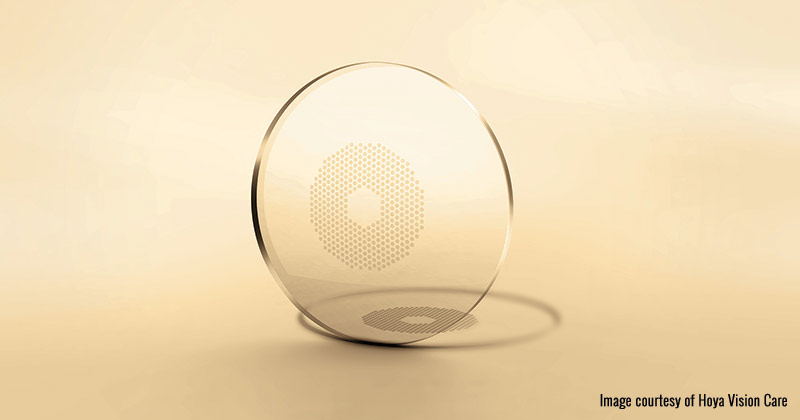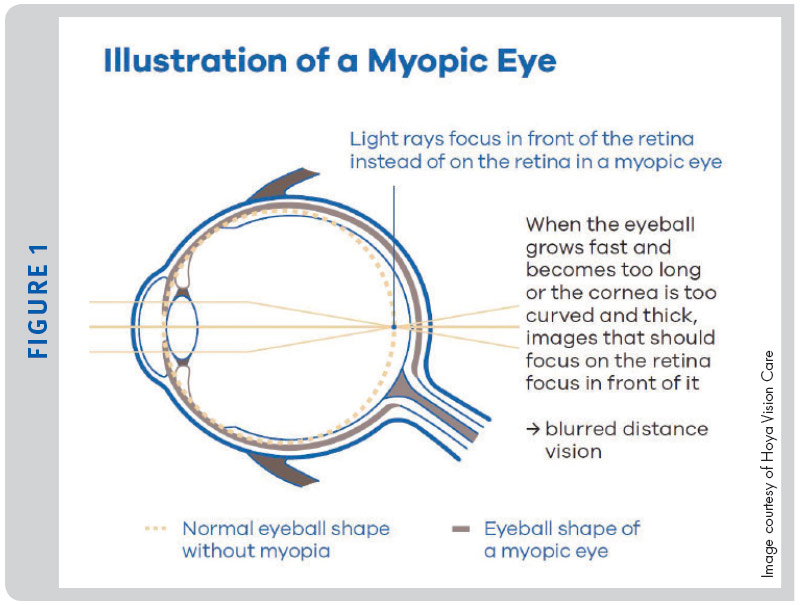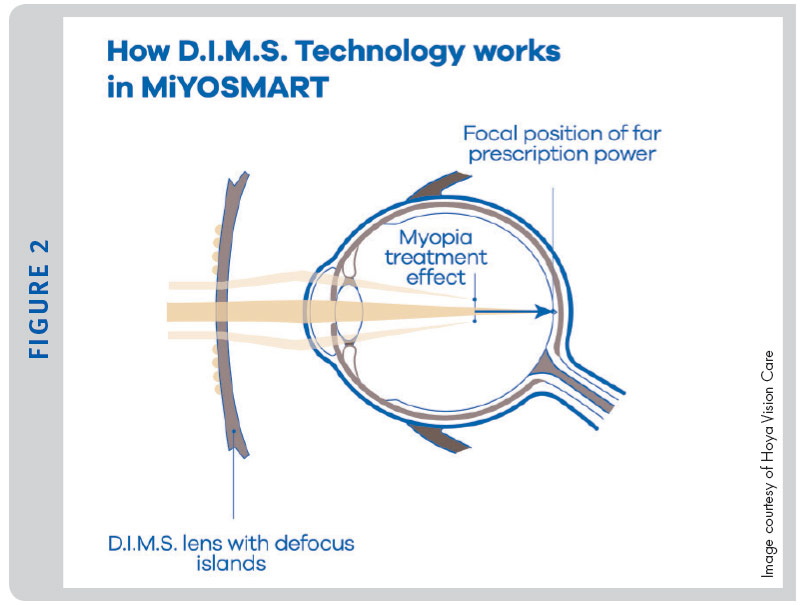
BY JOHNNA DUKES, ABOC
Myopia management is an exciting topic in the optical industry today because it offers an entirely different way for eyecare professionals to impact the daily lives of our myopic patients. For years, the industry standard when it came to treatment of myopic patients mostly focused on correcting their refractive error with the use of contact lenses and/or spectacle lenses, observing to see if there were any retinal issues and then sending the patient on their way.
Fast forward to today, when instead of reacting to myopia by only correcting the vision of myopic patients and waiting for it to get worse, we have the opportunity to be proactive in our approach by using specially designed spectacle lenses, contact lenses or atropine drops in the hopes of slowing the myopic progression for our patients.
This article focuses only on the spectacle lens options for myopia management. These specially designed lenses are already being prescribed and dispensed in Europe, Asia and Canada, and may soon be available in the United States, pending FDA approval.
When asked why these lenses are important, Dwight Akerman, OD, MBA, chief medical editor of Review of Myopia Management says: “Next-generation myopia control spectacle designs provide valuable innovation for eyecare practitioners as they manage myopic children. These designs have demonstrated comparative efficacy to orthokeratology, topical low-dose atropine and dual-focus/multifocal soft contact lenses. It’s important to begin intervention as soon as a child is diagnosed with myopia to have the greatest impact on reducing the final level of myopia. Next-generation myopia control spectacle designs open the door to myopia control for very young children, those not ready for contact lenses, and an adjunct to myopia control soft contact lenses or topical low-dose atropine.”
Given the high rate of myopia in the U.S., the arrival of myopia management products will likely be welcomed by practitioners and patients alike. Recent studies show that almost 42 percent of Americans are myopic. This is a cause for alarm, because this number has almost doubled in the last three decades, according to an article titled “Increased prevalence of myopia in the United States between 1971-1972 and 1999-2004” by S. Vitale, R. Sperduto, and F. Ferris published in the Archives of Ophthalmology in 2009. Additionally, the increase in rates of myopia isn’t localized only to the U.S. These staggering rate increases are happening all around the world. It is estimated that by the year 2050, nearly half of the population will be nearsighted.1

Hoya’s MiyoSmart lens utilizes Defocus Incorporated Multiple Segments (DIMS) technology
LONG-TERM THREATS TO VISION
Nearsightedness, in and of itself, is only part of the concern. There are some vision-threatening issues that come with high myopia; glaucoma, cataracts, retinal detachment and macular degeneration are some of the most troubling. For example, a recent study showed quite a difference between the risks a patient faces at a prescription of -3.00D versus one who is -5.00D.
Paragon Vision, a subsidiary of CooperVision, summarizes in their article titled “The Vision Threatening Dangers of Progressive Myopia: What You Need To Know”: “A nearsighted patient has 3 times the risk for developing glaucoma later in life if they have over a -3.00D nearsighted prescription, and there is a 14.6 percent greater risk for anyone who has a prescription over -5.00D.”2 “Patients with over a -3.00D prescription are 2 times more likely to develop cataracts. Those with over a -5.00D prescription are 5.5 times more likely to develop cataracts.”2 “A nearsighted prescription over –3.00D can increase the chance of retinal detachment times 3. The risk jumps up to 21.5 times more likely with a prescription over -5.00D.”2 “Those who have a nearsighted prescription over -3.00D are 2 times more likely to develop myopic macular degeneration, while over a -5.00D prescription has 40 times the risk.”2
Experts believe that if we can intervene at an earlier stage of myopia to slow the progression, the patient won’t progress to that -3.00D level, or certainly not the -5.00D degree or greater. Doing so could potentially lower the chances that these patients would face these serious sight threatening issues later in life.
Researchers have developed several different theories of myopia management based on peripheral retinal defocus. The peripheral retina has been shown to have a significant role on signaling axial length growth, and longer axial length usually indicates a greater degree of nearsightedness the patient experiences. When boiled down, the aim of myopia management is to prevent the peripheral retina from signaling for additional axial length of the eye, thus hopefully slowing the patient’s myopic progression.
Spectacle lenses designed for myopia management are a great option because they can be fit on younger children with little or no side effects especially when compared to use of contact lenses or atropine drops on young children. They are being shown to be well tolerated by all patients especially very young ones.3
SPECTACLE LENS SOLUTIONS FOR MANAGING MYOPIA
Here’s a quick rundown of a few of the spectacle lenses designed for myopia management. None are currently available in the U.S., and manufacturers may change the specifications of their products to fit the needs of the U.S. market. However, U.S. eyecare professionals should be aware of what’s being used internationally so they’ll be ready when these products become available here.

Hoya’s MiyoSmart lens utilizes Defocus Incorporated Multiple Segments (DIMS) technology, which features a 9 mm central optical zone with the specified distance correction and a 33 mm annular zone comprised of multiple 1 mm segments (or lenslets) that each have approximately +3.50D within each segment.

Hoya MiYoSmart Lens, featuring Defocus Incorporated Multiple Segments (DIMS) technology
ESSILOR STELLEST
Essilor’s Stellest lens is one that uses Highly Aspherical Lenslets (HAL) technology. This lens utilizes a 9 mm central optical zone that would contain the distance correction and 11 concentric rings of aspheric lenslets that are approximately 1.1 mm in diameter.4 The Stellest lens was recently designated by the FDA as a “Breakthrough Device” as per a press release dated May 17, 2021 and is currently available in Canada as of early 2022.
HOYA MIYOSMART
Hoya’s MiyoSmart lens utilizes Defocus Incorporated Multiple Segments (DIMS) technology. This design utilizes a 9 mm central optical zone with the specified distance correction and a 33 mm annular zone comprised of multiple 1 mm segments (or lenslets) that each have approximately +3.50D within each segment. The thought is that these areas of more plus power would cause retinal defocus and hopefully signal the peripheral retina to stop adding axial length to the eye.4
SIGHTGLASS VISION
A lens design from SightGlass Vision utilizes Diffusion Optics Technology with the theory that reducing the contrast detected by the retina may be helpful in preventing axial elongation. These lenses utilize thousands of light-scattering elements to reduce or diffuse light in order to reduce retinal contrast. These lenses are currently in clinical trials.4
The potential of these new myopia management lenses are indeed exciting. As eyecare
professionals, we’ll have new ways of improving the lives of many of our patients. ■
Resources:
1. Vitale S, Sperduto RD, Ferris FL, 3rd. Increased prevalence of myopia in the United States between 1971-1972 and 1999-2004. Archives of ophthalmology 2009; 127:1632-9
2. D.I. Filtcroft, The complex interactions of retinal, optical and environmental factors in myopia aetiology. Progress in Retinal and Eye Research 31(2012) 622-660
3. Philip K, PhD, Brien Holden Vision Institute, What’s New in Spectacle Lenses for Myopia Management. Review of Myopia Management. 01/01/2021
4. Bullimore M, MCOptom, PhD, FAAO, The Latest Science on Myopia Control Spectacles
Johnna Dukes is a board-certified optician based in Spirit Lake, Iowa, where she owns her own optical boutique. She is an author and an ABO approved continuing education speaker and the incoming president of the Opticians Association of America.












